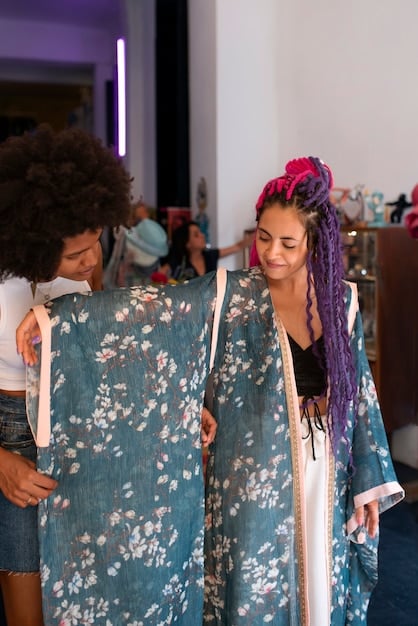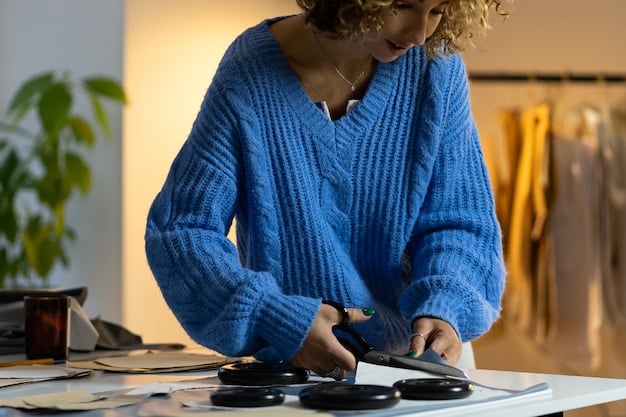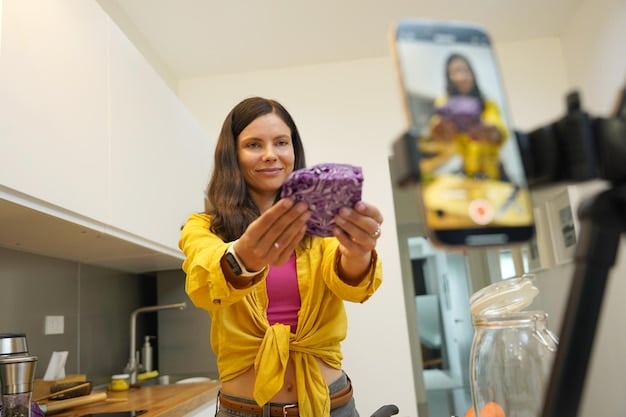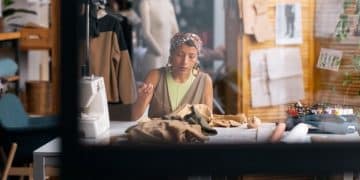What’s Driving the 15% Surge in Demand for US Independent Designers?

The increasing demand for independent US designers is fueled by several factors, including a growing consumer desire for unique, sustainable, and locally-sourced products, alongside the designers’ ability to offer personalized experiences and leverage digital platforms for direct engagement.
The fashion landscape is constantly evolving, and recently, there’s been a notable shift: a 15% increase in demand for independent US designers. But what’s driving the 15% increase in demand for independent US designers? Let’s delve into the key factors behind this surge and explore why consumers are increasingly choosing unique, locally-made pieces over mass-produced items.
The Rise of Conscious Consumerism
One of the primary drivers behind the increased demand is the rise of conscious consumerism. Today’s consumers are more informed and concerned about the impact of their purchasing decisions.
Sustainability and Ethical Practices
Consumers are increasingly seeking out brands that prioritize sustainability and ethical production practices. Independent designers often have a more transparent supply chain, allowing them to ensure fair labor practices and environmentally-friendly materials.
Supporting Local Economies
Choosing independent designers also means supporting local economies and small businesses. This resonates with consumers who want to contribute to their communities and foster a more localized economy.
- Increased awareness of the environmental impact of fast fashion.
- Desire to support fair labor practices and ethical sourcing.
- Growing preference for locally-made goods that boost local communities.
Conscious consumerism is not just a trend; it’s a fundamental shift in how people approach purchasing decisions. As consumers become more aware of the social and environmental impact of their choices, independent designers offering sustainable and ethical alternatives will continue to thrive.

The Appeal of Unique and Personalized Designs
In a world saturated with mass-produced goods, the appeal of unique and personalized designs is stronger than ever. Independent designers offer an alternative to the homogeneity often found in mainstream fashion.
Individuality and Self-Expression
Independent designers cater to consumers who want to express their individuality through their clothing. Their designs are often more creative, innovative, and less likely to be seen on everyone else.
Customization and Bespoke Services
Many independent designers offer customization options or even bespoke services, allowing consumers to create truly unique pieces tailored to their specific preferences. This level of personalization is rarely available from larger brands.
The allure of unique designs and personalized experiences is a significant driver in the growing demand for independent designers. Consumers are seeking out items that reflect their individual style and values, and independent designers are well-positioned to deliver these bespoke experiences.
The Power of Digital Platforms
Digital platforms have leveled the playing field for independent designers, providing them with powerful tools to reach a wider audience and build their brands.
E-commerce and Online Marketplaces
Platforms like Etsy, Shopify, and independent e-commerce sites have made it easier for designers to sell their products directly to consumers, bypassing traditional retail channels.
Social Media Marketing
Social media platforms like Instagram, Pinterest, and TikTok have become essential marketing tools for independent designers. They can showcase their work, connect with customers, and build a strong brand identity.

Digital platforms empower independent designers to connect directly with their target audience, build a strong online presence, and compete with larger brands. The accessibility and reach of these platforms are critical in driving the demand for independent designers.
The Quest for Quality and Craftsmanship
Consumers are increasingly valuing quality and craftsmanship over quantity and mass production. Independent designers often prioritize these values, creating pieces that are made to last.
Attention to Detail
Independent designers typically pay close attention to detail, using high-quality materials and employing skilled craftsmanship. This results in garments that are not only beautiful but also durable and long-lasting.
Investment Pieces
While independent designs may come with a higher price tag, consumers often view them as investment pieces that will stand the test of time. The quality and craftsmanship justify the cost for many buyers.
- Emphasis on using high-quality, durable materials.
- Skilled craftsmanship and attention to detail in every piece.
- Creating garments designed to last, reducing the need for frequent replacements.
The pursuit of quality and craftsmanship is a key factor in the growing demand for independent designers. Consumers are willing to invest in pieces that are well-made, unique, and reflect their appreciation for artistry and skill.
The Desire for Community and Connection
In an increasingly disconnected world, consumers are seeking out brands that foster a sense of community and connection. Independent designers often cultivate strong relationships with their customers, creating a loyal following.
Direct Interaction with Designers
Independent designers often interact directly with their customers, whether through social media, pop-up shops, or personal consultations. This direct engagement creates a more personal and meaningful relationship.
Supporting a Creative Ecosystem
By supporting independent designers, consumers are also supporting a larger creative ecosystem. This resonates with those who value artistic expression and want to contribute to a thriving cultural scene.
The desire for community and connection is a significant factor in the rise of independent designers. Consumers are drawn to brands that offer a more personal and engaging experience, fostering a sense of belonging and shared values.
Impact of Economic Factors
Economic factors also play a role in the demand for independent US designers. Shifting economic landscapes and consumer spending habits influence the fashion market.
Resilience During Economic Downturns
Independent designers can be more agile and responsive to market changes, allowing them to adapt quickly during economic downturns. Their ability to pivot and cater to specific consumer needs can make them more resilient.
Value for Money
Consumers often perceive independent designs as offering better value for money, considering the quality, craftsmanship, and unique design elements. This perception drives demand, especially when consumers are seeking durable and stylish pieces.
- Adaptability of independent designers to changing market conditions.
- Perception of better value for money in terms of quality and design.
- Support for economic resilience in local communities.
Economic factors influence consumer behavior, highlighting the resilience and value proposition of independent designers. As consumers navigate changing economic landscapes, they often turn to independent designers for their quality, unique offerings, and support for local economies.
| Key Aspect | Brief Description |
|---|---|
| 🌱 Sustainability | Eco-friendly materials and ethical production drive demand. |
| ✨ Uniqueness | Consumers seek personalized, creative designs. |
| 📱 Digital Platforms | E-commerce and social media enhance designer reach. |
| 💪 Community | Direct designer interaction fosters loyalty. |
Frequently Asked Questions
▼
Independent designers offer unique, sustainable options that resonate with consumers seeking alternatives to mass-produced fashion. Their focus on personalization and ethical practices also attracts a growing customer base.
▼
E-commerce sites and social media enable independent designers to reach wider audiences, market directly to consumers, and build their brand identity without relying on traditional retail infrastructure.
▼
Many independent designers prioritize sustainability by using eco-friendly materials, ensuring fair labor practices, and minimizing waste in their production processes, aligning with conscious consumer values.
▼
Independent designs can be pricier due to higher-quality materials, skilled craftsmanship, and ethical production. Consumers often view these pieces as investments in durable, unique items.
▼
Support independent designers by purchasing their products, following them on social media, sharing their work with others, and participating in local markets or events where they showcase their designs.
Conclusion
The 15% increase in demand for independent US designers is a testament to evolving consumer values and the unique offerings of these creative entrepreneurs. From conscious consumerism and personalized designs to the power of digital platforms and the quest for quality, multiple factors are converging to fuel this surge. As consumers continue to seek out sustainable, unique, and community-focused brands, independent designers are poised to thrive and shape the future of fashion.





